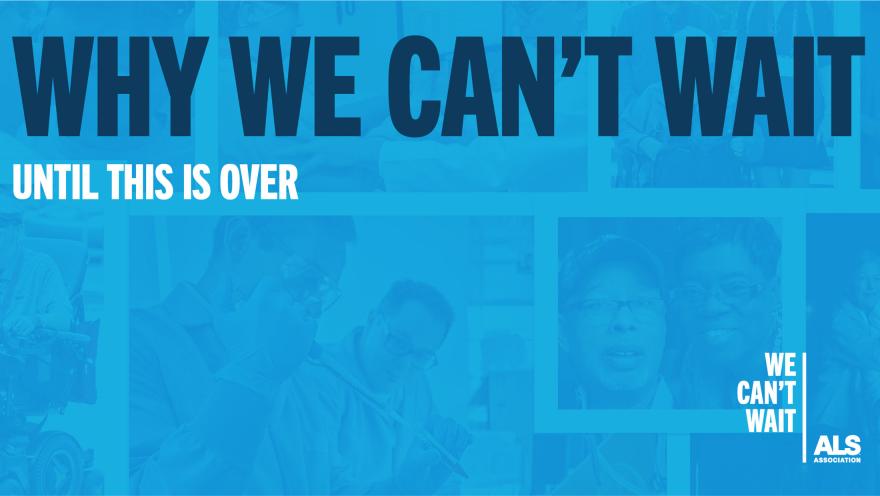By Calaneet Balas
As some quarantines across the country ease and others regress to more restrictive states, many of us are reminded of the everyday things we took for granted. We socialized, celebrated holidays and birthdays with family, wound our way through crowded grocery stores and sent kids off to school. We went about the business of life, not anticipating that a pandemic would so dramatically alter the way we live our lives.
And while it's generally assumed that life will eventually return to what we think of as “normal,” that is not going to be the experience for approximately 20,000 Americans living with ALS today. Pandemic or not, they will still live with the daily fear that one day, they will lose their fight to a disease that is slowly robbing them of the ability to walk, talk, eat and breathe.
This stark reality is why we can’t wait until this pandemic is over to accelerate our pursuit for improved treatments and a cure. The fact that the whole world is affected by something we cannot control is not an excuse to wait.
It’s a mandate to act.
Urgent Innovations
The pandemic brought into sharper focus our need to expedite innovations for more consistent, accessible care and outreach. We’ve backed and implemented novel approaches to technology that support continuity of our mission – and even beyond – the pandemic.
Take telemedicine for example. An urgently necessary innovation right now, it empowers access to certain care services for people with ALS in the relative comfort and safety of their own homes. It’s a treatment option we’ve advocated for several years and one we will seek to expand in the future as an imperative for agile, accessible treatment.
Each of our 73 Certified and 22 Recognized clinics responded to COVID-19 by transitioning to telehealth to ensure patients would stay current with their physicians and not have to leave the safety of their homes. Our nationwide network of care service leads, important members of our clinic teams, are accessible online for support between clinic visits.
This new application of an existing communications technology extends to ALS support groups, too. Today, more and more people are joining virtual sessions for the chance to connect, share stories, and pass on information with others in our community. By effectively removing the physical rigors of traveling to a physical meeting, people with ALS and their families can maintain and build a community that sustains them safely and conveniently online.
Related, The ALS Association did not let social distancing slow our fight for federal research funds or access to the technology that enhances their lives. Although Capitol Hill was closed to visitors, our public policy team quickly moved to online outreach. During our first-ever virtual advocacy conference in May, our advocates held more than 350 virtual meetings with members of Congress. This was an important work around to keep our ALS community top-of-mind in Washington, DC.
Advancing Research
Some research and clinical trials have paused for the safety of ALS patients and health care practitioners; however, we continue to push advances forward where possible, and we’re seeing important progress.
For example, the first participants have been enrolled in the HEALEY ALS Platform Trial at Massachusetts General Hospital, testing three proposed drug regimens: Zilucoplan, Verdiperstat, and CNM-Au8 nanocrystalline gold.
Our partner Biogen recently published promising results from its phase 1–2 Trial of Antisense Oligonucleotide Tofersen for SOD1 ALS and is now actively enrolling participants for its Phase 3 Valor study. It also announced that there is an open-label extension available in the study.
Meantime, research data just released by Dr. Michael Bereman at North Carolina State University found that blood plasma analysis could be key to speeding up the process of diagnosing the disease and monitoring disease progression.
And a funding partnership among The Association, I AM ALS and BrainStorm announced this summer will draw insights from data and samples collected from patients enrolled in BrainStorm’s ongoing phase 3 clinical trial of its NurOwn treatment to see if the therapy is hitting its targets in the nervous system and generating measurable changes in biomarkers that would signal that the drug works.
Leading Beyond this Moment
We are managing the COVID-19 crisis, but at the same time, we are looking ahead, anticipating the environment once the virus no longer poses an imminent threat to people in our ALS community. We believe the innovations and agility we’ve adopted to respond to crisis will continue to serve us afterwards, and we will be even better positioned to deliver on our mission.
Faster, bolder, more connected, farther reaching…The ALS Association has never been better prepared to meet the needs of the people we serve. And we are holding fast to the momentum. We are here for you regardless of obstacles in the external environment. We’re moving forward because we can’t wait to find a cure.
You can read more about our activities in our 2020 mid-year report. I also invite you to visit our We Can’t Wait website for more stories from our ALS community about our urgent work to find a cure.


Join the conversation. Please comment below.